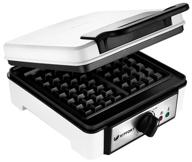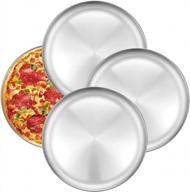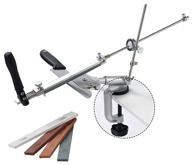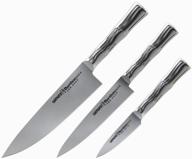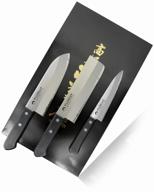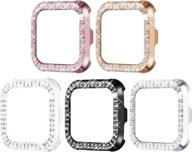Sharpen Up Your Cooking Game
A sharp knife is one of the most important tools in any kitchen. With a razor sharp edge, you can chop, slice, and dice ingredients with ease, speed, and precision. Dull knives can be dangerous, requiring extra force that can lead to slipping and injuries. Keeping your knives sharpened should be part of your regular kitchen maintenance.
Similar products
How Dull Knives Can Impact Your Cooking
- Requires more force and increases hand fatigue
- Leads to uneven, ragged cuts
- Can cause ingredients to stick to the blade
- Increases the risk of slipping and injuries
- Damages produce by crushing instead of cutting cleanly
Dull knives make cooking much harder and less enjoyable. Tasks take longer, require more effort, and the end results suffer. Sharpening your knives regularly can completely transform your experience in the kitchen.
How Often Should You Sharpen Your Knives?
In general, most home cooks should plan to sharpen their knives:
- High carbon steel knives - Every 3-4 uses
- Stainless steel knives - Every 6-8 uses
- Ceramic knives - Once every few months
However, how often you need to sharpen depends on factors like:
- How much you use the knife
- What you're cutting (soft produce vs. hard materials)
- If the blade has been damaged
- Your personal preference on sharpness
Get to know your knives and sharpen more frequently if you notice them feeling dull.
Sharpening Options
You have several options for sharpening household knives:
Whetstones
Whetstones (also called sharpening stones) are rectangular blocks made of materials like silicon carbide, aluminum oxide, or ceramic. To use them, you drag the knife blade across the stone at an angle to grind away material and create a new sharp edge. Whetstones require practice to master, but allow for precise sharpening.
Electric sharpeners
Electric sharpeners have spinning wheels that grind the knife blade to sharpen it. They're faster and easier to use than whetstones, but can take off more material than necessary. Use with caution to avoid excess wear on knife edges.
Honing rods
Honing rods realign and straighten the knife's edge between full sharpenings. Regular honing extends the life of your sharp edge. Honing is recommended before each use.
Sharpening Tips
- Use the proper sharpening angle for the knife's shape.
- Apply even and consistent pressure along the length of the blade.
- Work slowly and check the edge often.
- Rinse knife after sharpening to remove metal debris.
- Hone the knife after each sharpening to align and polish the edge.
Like many skills, sharpening takes practice. Be patient with yourself as you learn how to consistently sharpen your knives to a razor edge. The benefits are well worth the effort.
Another interesting products
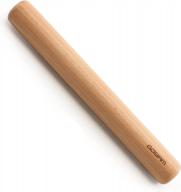

35 Review

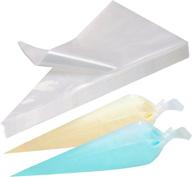

41 Review

Best Knife Sets for Every Budget
A quality knife set is an essential investment for any home cook. With the wide range of prices, features, and styles available, it can be tricky to determine which knife set provides the best value within your budget. This guide examines some of the best knife sets tailored for budgets ranging from under $100 to over $500.
Under $100
While you make some sacrifices at this price point, there are still solid options for basic knife sets:
Cuisinart 15-piece Knife Set
- Stainless steel blades
- Ergonomic handles
- Includes knife block
- Around $50
A great budget option from a reliable brand. The steel isn't high-end but still holds an edge reasonably well.
J.A. Henckels International Statement Knife Set
- Stamped stainless steel blades
- Polypropylene handles
- Includes knife block
- Around $60
You get Henckels' signature quality without the premium price. Great starter set for a first kitchen.
Top products in 🍴 Cutlery & Knife Accessories
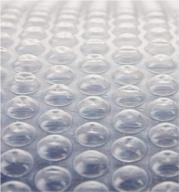

33 Review

$100 - $300
This middle price tier offers an excellent balance of quality and value:
Wüsthof Classic Ikon 7-piece Knife Set
- Forged high-carbon stainless steel
- Contoured handles fit hand nicely
- Full tang blades for balance
- Around $270
Wüsthof knives provide top notch performance. This set will last years with proper care.
Zwilling J.A. Henckels Twin Signature 7-pc Knife Set
- Ice-hardened friodur blades
- Seamless, hygienic handles
- Knives made in Germany
- Around $130
An exceptionally sharp set from the heritage German knife maker. Great for precise cuts.
Over $300
Premium materials and craftsmanship define these high-end sets:
Miyabi Birchwood SG2 7-pc Knife Set
- Hand-honed SG2 steel (63 Rockwell hardness)
- Mirror-polished edge
- Handcrafted in Japan
- Around $500
Simply one of the finest cuts of steel with exceptional edge retention. A work of art in the kitchen.
Shun Classic 10-piece Knife Set
- Vg-max cutting core, Damascus cladding
- Hammered tsuchime finish
- Handcrafted in Japan
- Around $500
With layered steel and unique hammered textures, these handmade Japanese knives are a stunning addition to your kitchen.
While expensive, these luxury sets will provide a lifetime of use if cared for properly. A worthwhile investment for serious cooks.
At any budget level, look for strong, balanced knives that feel comfortable in your hand. With the right set, cooking can be a real joy.
How to Choose the Right Knife for the Job
Having the right knife makes food prep easier, safer, and more efficient. Matching the knife to the task results in better cuts and less wear on the blade's edge.
Factors to Consider
- Ingredient texture - Hard vs. soft
- Cutting task - Slicing, chopping, mincing
- Knife weight - Heavier for sturdiness, lighter for precision
- Knife shape - Different shapes for ease of use
Common Kitchen Knives and Uses
Chef's Knife
- All-purpose knife for chopping, slicing, dicing
- Wide blade great for scooping up prepared ingredients
- Choose 8-10 inches for home kitchens
Santoku Knife
- Similar to a chef's knife but with indentations in blade
- Great for mincing and thinly slicing meats and produce
- Blade typically 5-7 inches long
Utility Knife
- Lightweight for cutting fruits, vegetables, small garnishes
- Thin 4-6 inch blade useful for tasks requiring precision
- Easy to control for peeling, trimming, decorating
Boning Knife
- Flexible, narrow blade to remove meat from bones
- Pointed tip lets you scrape meat out of crevices
- Shallow belly keeps knuckles off cutting board
Bread Knife
- Long, serrated blade saws through crusty bread cleanly
- 8-10 inches ideal for most loaves
- Gentle sawing motion to avoid compressing bread
Take stock of the ingredients and recipes you work with most, and choose knives suited for those specific tasks. This ensures you've always got the right tool for the job.
Knife Safety Tips for the Home Cook
Sharp knives make cooking easier and more efficient, but they require caution and care to use safely. Follow these tips to improve your knife skills while protecting yourself in the kitchen.
Choose the Right Knife
Pick a knife suited for the specific cutting job:
- Paring knife for precision tasks
- Utility knife for slicing fruits and vegetables
- Chef’s knife for chopping, dicing, mincing
Maintain Your Knives
- Sharpen regularly for clean cuts and less wear
- Hone before each use to align the edge
- Wash carefully by hand and dry right away
Hold Properly
- Use a pinch grip with thumb and finger on the blade
- Keep other fingers curled under while cutting
- Allow knuckles to guide blade for consistency
Cut Carefully
- Keep tip pointed down towards cutting board
- Use smooth, deliberate strokes rather than hacking
- Cut away from yourself
- Never cut towards your hand
Respect Your Blades
- Lay knife down when not in active use
- Carry carefully with blade pointed down
- Store in knife block or sheath for protection
Avoid Accidents
- Clear clutter from work area
- Secure cutting board so it doesn't slip
- Cut produce on stable, protected surfaces
- Dry hands and blade if they get wet or slippery
Taking time to learn proper knife skills, control, and care will keep you safe and confident in the kitchen.
Must-Have Knife Accessories for Serious Chefs
Quality knives are just the beginning. Equip your kitchen like a pro with these must-have accessories for storing, honing, and sharpening your knives.
Knife Block
- Safely stores knives and protects blades
- Offers easy access when cooking
- Get plenty of slots for full knife sets
- Material resists moisture: wood, acrylic, or bamboo
Honing Steel
- Use before cutting to align and straighten edge
- Extends life of sharpening and edge
- Diamond surface best for super hard steel knives
- Ceramic rod good for maintaining softer metal
Cutting Board
- Protects knife edges from damage
- Get separate boards for meat, produce to avoid cross-contamination
- Hardwood or durable composite materials
- Sanitize thoroughly after each use
Whetstone
- Waterstone for sharpening and fine honing
- Dual-sided for coarse and fine grits
- Creates razor sharp edges
- Takes practice but best edge for quality knives
Knife Sheaths
- Protects blade and fingers when storing or transporting
- Fits individual knives for safe carrying
- Leather or plastic
- Essential for chef’s knife, boning knife, slicer
Cut Resistant Glove
- Provides grip and protects hand when cutting
- Useful when cutting hard foods like squash, coconut
- Levels 5 or higher for best protection
Investing in high quality accessories makes using your knives a pleasure and ensures their optimal performance.
Keep Your Knives Razor Sharp with Proper Care
Quality knives can last for years or even decades when properly maintained. Follow these tips to keep your cutlery performing like new.
Use a Cutting Board
Never cut directly on countertops or plates. Use a cutting board to protect the knife's edge from damage during use. Hardwood, plastic, or rubber boards are best options.
Wash Carefully
- Wash knives individually by hand, not in the dishwasher.
- Use mild soap and warm water, rinse and dry immediately.
- Quick drying prevents corrosion and discoloration.
Store Properly
- Use knife blocks, sheaths, or in-drawer knife trays.
- Never allow blades to rub together or hit other utensils.
- Avoid overly humid areas.
Hone Frequently
- Use a honing steel to realign the edge before each use.
- Helps maintain sharpness between full sharpenings.
- A few light strokes on each side is all that's needed.
Sharpen Regularly
- How often depends on knife quality and usage.
- Higher carbon steel may need sharpening after just a few uses.
- Stainless steel can go weeks between sharpenings.
Use Proper Technique
- Maintain the existing bevel angle.
- Use a light touch; don't grind away too much metal.
- Work the entire blade edge evenly.
Consider a Professional
- Professional sharpening services will use top equipment.
- Experts can repair damaged edges or reshape as needed.
- Recommended for valuable, fragile knives.
With regular honing and sharpening along with careful use and storage, your quality knives will serve you well for many years.
Designer Cutlery to Make a Statement in Your Kitchen
Quality knives are essential in any kitchen, but they can also provide a stylish focal point with unique materials, artistic touches, and luxury details. Check out these designer knives that are as beautiful as they are functional.
Misono UX10
- Hand-ground dragon pattern Damascus steel
- Mirror-polished Swedish steel cutting edge
- Luxurious Pakkawood handle
- Distinctive chestnut leaf engraving
With meticulous craftsmanship and stunning layered steel, the Misono UX10 marries beauty and performance.
Yoshihiro VG-10 - Hammered tsuchime finish
- Hand-sharpened VG10 steel
- Traditional Japenese handle
- Elegant presentation box included
This unique hammered texture and ultra-sharp VG-10 steel make this chef's knife a work of art.
Chroma Type 301
- Designed by F.A. Porsche
- Mirror-finished aerospace grade titanium
- Colorful, anodized aluminum handle
- Modern, sleek profile
With its precision engineering and sleek, colorful handles, this set has designer style.
Kai Wasabi Black
- High-carbon stainless steel
- Distinctive black finish
- Textured handle for secure grip
- Angled bolster for comfort
The stylish Kai Wasabi Black set brings power and performance in an eye-catching package.
Beyond basic function, these designer knives allow you to make a bold statement in your kitchen. With unique touches and attention to detail, they transform essential cutlery into objects of desire.
What is the benefit of Amazon Prime when buying "Cutlery & Knife Accessories"?
Amazon Prime provides a number of benefits that can be very useful when shopping for cutlery and knife accessories online. Here are some of the key perks:
Free Two-Day Shipping
One of the biggest advantages of Amazon Prime is free two-day shipping on millions of eligible items. This means you can get your knives, knife blocks, sharpeners and other accessories delivered quickly without paying extra shipping fees.
Free One-Day and Same-Day Delivery
For those times when you need something urgently, Prime members in eligible zip codes can get free one-day delivery on qualifying orders over $35. Prime members in select cities can even get items delivered the same day for a fee.
Try Before You Buy
The Prime Wardrobe feature allows you to try eligible items like knife sets before buying them. You can have orders shipped to your door, try them at home, and only pay for what you keep.
Premium Shipping Options
In addition to free two-day shipping, Prime unlocks other premium shipping options like overnight delivery at reduced rates. This gives you more flexibility for faster shipping if needed.
Access to Exclusive Deals
Prime members get 30 minute early access to Lightning Deals and other exclusive discounts and sales. This lets you score deals on knife sets, cutting boards and other kitchen items before non-Prime members.
Overall, a Prime membership provides convenience, flexibility and savings when ordering cutlery and accessories. The fast, free shipping alone makes it worthwhile for frequent Amazon shoppers.
What Are The Best Knives For Cutting Vegetables??
There are several knives that are great for cutting vegetables. Here are some of the best knives for cutting vegetables according to the search results:
- Santoku Knife: This knife is great for slicing, dicing, and mincing a variety of vegetables.
- Chef Knife: This knife features a curved cutting edge with a pointed tip and is ideal for mincing vegetables like potatoes and onions, as well as cutting through tougher vegetables like winter squash.
- Paring Knife: This knife is ideal for small vegetables and can be used to peel vegetables, making it one of the most versatile knives in your kitchen.
- Nakiri Knife: This knife is best for thin slices of vegetables.
- Produce Knife: This knife is almost specifically tailored for cutting up vegetables and fruit produce and is arguably the best for them.
- Utility Knife: This knife is smaller than a chef’s knife but larger than the paring knife and is ideal for slicing and dicing mid-sized veggies and herbs.
- Vegetable Cleaver: This knife is a fantastic knife for large vegetables.
It's important to use a knife that is well-balanced, comfortable to hold, and sharp when cutting vegetables. A sharp knife is a safer knife since it requires less pressure to cut through something.
What Are The Differences Between A Santoku Knife And A Chef Knife For Cutting Vegetables??
The Santoku knife and the Chef knife are both great for cutting vegetables, but they have some differences. Here are the key differences between the two knives for cutting vegetables:
Santoku Knife:
Chef Knife:
When it comes to using the Chef Knife vs. the Santoku Knife for cutting vegetables, both serve as multi-purpose tools in the kitchen. However, there are some advantages to using one over the other. The Western-style Chef’s Knife tends to be thicker and heavier, making it the workhorse for your kitchen, while the light-weight Japanese-style Santoku is perfect for fine, delicate slicing. Choosing between the Chef Knife and the Santoku can also be a matter of personal preference and chopping style.
What Are The Advantages Of Using A Santoku Knife For Cutting Vegetables??
There are several advantages to using a Santoku knife for cutting vegetables, according to the search results:
- Thin blade: Santoku knives have thinner blades than many other knives, which allows for more accurate chopping and dicing of vegetables.
- Light-weight: Santoku knives are lighter in weight than many other knives, which makes them easier to handle and can reduce hand strain.
- Versatility: Santoku knives have more than one use, which can reduce the number of knives you need to own. They can be used for a variety of tasks, including preparing thinly sliced vegetables, fruits, fish, and meats.
- Flatter edge: The flatter edge of the Santoku allows for more of an up-and-down chopping motion that requires lifting the blade off the cutting board between each cut, making it ideal for tasks that involve creating perfectly uniform pieces.
- Precision: Santoku knives are sharp, ensuring that vegetables and meats can be sliced with precision.
- Blade height: The Santoku knife has a bit more blade height than a Gyuto, which can be comfortable for people who find their knuckles come in contact with the cutting board when chopping.
- Comfort: Santoku knives are derived from Japanese vegetable knives and are optimized for techniques where the pivot point is the hand/wrist of the user and the knife is lifted off the board in its entirety between cuts, making them more comfortable to use for some people.
Overall, the Santoku knife is a versatile and precise tool that can be a great choice for cutting vegetables.






